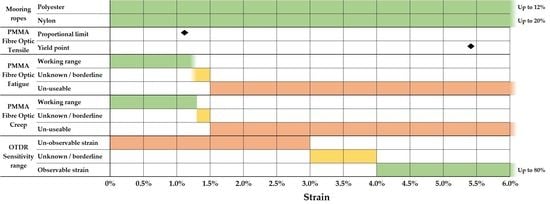Investigating Polymer Fibre Optics for Condition Monitoring of Synthetic Mooring Lines
Abstract
1. Introduction
1.1. Synthetic Rope Mooring Systems
1.2. Condition Monitoring Using Optical Fibres
1.3. Paper Outline
2. Materials and Methods
2.1. Establishing the Mechanical Operating Envelope
2.1.1. Test Configuration
2.1.2. Tension Testing
- Proportional limit: Established by conducting a least squares regression to calculate the coefficient of determination (R2). An R2 value of 0.999 is required to consider the data ‘linear’. Once R2 value drops below 0.999, the data is no longer considered linear;
- Yield point: The point at which peak stress is observed before strain softening commences.
2.1.3. Creep Testing
2.1.4. Fatigue Testing
2.2. Optical Time Domain Reflectometer Investigation
Test Configuration
3. Results
3.1. Establishing the Operating Envelope
3.1.1. Proportional Limit and Yield Point
3.1.2. Creep Investigations
3.1.3. Fatigue Investigations
3.2. Optical Time Domain Reflectometer Results
4. Discussion
5. Conclusions
Supplementary Materials
Author Contributions
Funding
Acknowledgments
Conflicts of Interest
References
- Weller, S.D.; Johanning, L.; Davies, P.; Banfield, S.J. Synthetic mooring ropes for marine renewable energy applications. Renew. Energy 2015, 83, 1268–1278. [Google Scholar] [CrossRef]
- Davies, P.; Johanning, L.; Weller, S.D.; Banfield, S.J. A review of synthetic fibre moorings for marine energy applications. In Proceedings of the 5th International Conference on Ocean Energy (ICOE 2014), Halifax, NS, Canada, 4–6 November 2014. [Google Scholar]
- Gordelier, T.; Parish, D.; Thies, P.R.; Johanning, L. A novel mooring tether for highly-dynamic offshore applications; mitigating peak and fatigue loads via selectable axial stiffness. J. Mar. Sci. Eng. 2015, 3, 1287–1310. [Google Scholar] [CrossRef]
- Ridge, I.M.L.; Banfield, S.J.; Mackay, J. Nylon Fibre Rope Moorings for Wave Energy Converters. In Proceedings of the Oceans 2010, Seattle, WA, USA, 20–23 September 2010. [Google Scholar]
- Rebel, G.; Chaplin, C.R.; Groves-Kirkby, C.; Ridge, I.M.L. Condition monitoring techniques for fibre mooring ropes. Insight 2000, 42, 384–390. [Google Scholar]
- Smith, D.B.; Williams, J.G. Direct measurement of large strains in synthetic fiber mooring ropes using polymeric optical fibers. In Proceedings of the Offshore Technology Conference 2002, Houston, TX, USA, 6–9 May 2002. [Google Scholar]
- Oland, E.; Schlanbusch, R. A review of condition monitoring techniques for fiber ropes. In Proceedings of the 62nd International Instrumentation Symposium (IIS) / Machinery Failure Prevention Technology (MFPT) 2016, Dayton, OH, USA, 24 May 2016. [Google Scholar]
- Merzbacher, C.; Kersey, A.D.; Friebele, E.J. Fiber optic sensors in concrete structures: A review. Smart Mater. Struct. 1996, 5, 196. [Google Scholar] [CrossRef]
- Webb, D.J. Fibre bragg grating sensors in polymer optical fibres. Meas. Sci. Technol. 2015, 26, 092004. [Google Scholar] [CrossRef]
- Chen, X.; Zhang, C.; Webb, D.J.; Peng, G.D.; Kalli, K. Bragg grating in a polymer optical fibre for strain, bend and temperature sensing. Meas. Sci. Technol. 2010, 21, 094005. [Google Scholar] [CrossRef]
- Liehr, S.; Wendt, M.; Krebber, K. Distributed perfluorinated POF strain sensor using OTDR and OFDR techniques. In Proceedings of the 20th International Conference on Optical Fibre Sensors, Edinburgh, UK, 5 October 2009. [Google Scholar]
- Large, M.C.; Moran, J.; Ye, L. The role of viscoelastic properties in strain testing using microstructured polymer optical fibres (mPOF). Meas. Sci. Technol. 2009, 20, 034014. [Google Scholar] [CrossRef]
- Kiesel, S.; Peters, K.; Hassan, T.; Kowalsky, M. Large deformation in-fiber polymer optical fiber sensor. IEEE Photonics Technol. Lett. 2008, 20, 416–418. [Google Scholar] [CrossRef]
- Husdi, I.R.; Nakamura, K.; Ueha, S. Sensing characteristics of plastic optical fibres measured by optical time-domain reflectometry. Meas. Sci. Technol. 2004, 15, 1553. [Google Scholar] [CrossRef]
- Liehr, S.; Lenke, P.; Wendt, M.; Krebber, K.; Seeger, M.; Thiele, E.; Metschies, H.; Gebreselassie, B.; Munich, J.C. Polymer optical fiber sensors for distributed strain measurement and application in structural health monitoring. IEEE Sens. J. 2009, 9, 1330–1338. [Google Scholar] [CrossRef]
- Bilro, L.; Alberto, N.; Pinto, J.L.; Nogueira, R. Optical sensors based on plastic fibers. Sensors 2012, 12, 12184–12207. [Google Scholar] [CrossRef] [PubMed]
- Arrospide, E.; Bikandi, I.; García, I.; Durana, G.; Aldabaldetreku, G.; Zubia, J. Mechanical properties of polymer-optical fibres 7. Polym. Opt. Fibres Fibre Types Mater. Fabr. Characterisation Appl. 2016, 201–216. [Google Scholar] [CrossRef]
- Peters, K. Polymer optical fiber sensors—A review. Smart Mater. Struct. 2010, 20, 013002. [Google Scholar] [CrossRef]
- Jiang, C.; Kuzyk, M.G.; Ding, J.L.; Johns, W.E.; Welker, D.J. Fabrication and mechanical behavior of dye-doped polymer optical fiber. J. Appl. Phys. 2002, 92, 4–12. [Google Scholar] [CrossRef]
- Harnois, V.; Thies, P.R.; Johanning, L. On peak mooring loads and the influence of environmental conditions for marine energy converters. J. Mar. Sci. Eng. 2016, 4, 29. [Google Scholar] [CrossRef]
- Rogers, A. Distributed optical-fibre sensing. Meas. Sci. Technol. 1999, 10, R75. [Google Scholar] [CrossRef]
- Agilent Technologies, Optical Time Domain Reflectometers—A Pocket Guide. 2001. Available online: http://literature.cdn.keysight.com/litweb/pdf/E6000-91017.pdf (accessed on 2 February 2020).
- Smith, D.B.; Williams, J.G. Monitoring axial strain in synthetic fiber mooring ropes using polymeric optical fibers. In Proceedings of the ASME 2003 22nd International Conference on Offshore Mechanics and Arctic Engineering, Cancun, Mexico, 8–13 June 2003. [Google Scholar]
- Kiesel, S.; Peters, K.; Hassan, T.; Kowalsky, M. Behaviour of intrinsic polymer optical fibre sensor for large-strain applications. Meas. Sci. Technol. 2007, 18, 3144. [Google Scholar] [CrossRef]
- Anritsu, Understanding OTDRs. 2011. Available online: https://rossfibersolutions.com/fiber-optic-pdfs/Anritsu-understanding-otdrs.pdf (accessed on 2 February 2020).
- Cantournet, S.; Desmorat, R.; Besson, J. Mullins effect and cyclic stress softening of filled elastomers by internal sliding and friction thermodynamics model. Int. J. Solids Struct. 2009, 46, 2255–2264. [Google Scholar] [CrossRef]
- Stefani, A.; Andresen, S.; Yuan, W.; Bang, O. Dynamic characterization of polymer optical fibers. IEEE Sens. J. 2012, 12, 3047–3053. [Google Scholar] [CrossRef]
- Abang, A.; Webb, D.J. Effects of annealing, pre-tension and mounting on the hysteresis of polymer strain sensors. Meas. Sci. Technol. 2013, 25, 015102. [Google Scholar] [CrossRef]
- Harbach, N.G. Fiber Bragg gratings in polymer optical fibers. Ph.D. Thesis, Applied Optics EPFL, Lausanne, Switzerland, 15 November 2008. [Google Scholar]
- Yang, D.X.; Yu, J.; Tao, X.; Tam, H. Structural and mechanical properties of polymeric optical fiber. Mater. Sci. Eng. A 2004, 364, 256–259. [Google Scholar] [CrossRef]
- Broadway, C.; Min, R.; Leal-Junior, A.G.; Marques, C.; Caucheteur, C. Toward commercial polymer fiber Bragg grating sensors: Review and applications. J. Lightwave Technol. 2019, 37, 2605–2615. [Google Scholar] [CrossRef]
- Min, R.; Ortega, B.; Marques, C. Latest achievements in polymer optical fiber gratings: Fabrication and applications. Photonics 2019, 6, 36. [Google Scholar] [CrossRef]
- O’Hear, N. Optical Scanning Apparatus for Ropes nondestructive test monitoring system. In Proceedings of the OCEANS 2003, San Diego, CA, USA, 22–26 September 2003. [Google Scholar]
- Robertson, P.A.; Ludden, B.P. A fibre optic distributed sensor system for condition monitoring of synthetic ropes. In Proceedings of the IEE Colloquium on Optical Techniques for Smart Structures and Structural Mmonitoring (Digest No. 1997/033), London, UK, 17 February 1997. [Google Scholar]
- Corning BOTDR Measurement Techniques and Brillouin Backscatter Characteristics of Corning Sigle-Mode Optical Fibres. 2015. Available online: https://www.corning.com/media/worldwide/coc/documents/Fiber/RC-%20White%20Papers/WP-General/WP4259_01-15.pdf (accessed on 2 February 2020).
- Marques, C.A.F.; Webb, D.J.; Andre, P. Polymer optical fiber sensors in human life safety. Opt. Fiber Technol. 2017, 36, 144–154. [Google Scholar] [CrossRef]
- Nagarkar, K.; Ostroverkhov, V.; Balasubramaniam, M.; Rubinsztajn, S.; Koste, G.; Dekate, S.; Mandal, S.; Stecher, T. Optical fiber reliability in subsea monitoring. In Proceedings of the SPIE Sensing Technology + Applications 2015, International Society for Optics and Photonics, Baltimore, MD, USA, 13 May 2015. [Google Scholar]
- Brönnimann, R.; Nellen, P.M.; Sennhauser, U. Application and reliability of a fiber optical surveillance system for a stay cable bridge. Smart Mater. Struct. 1998, 7, 229. [Google Scholar] [CrossRef]
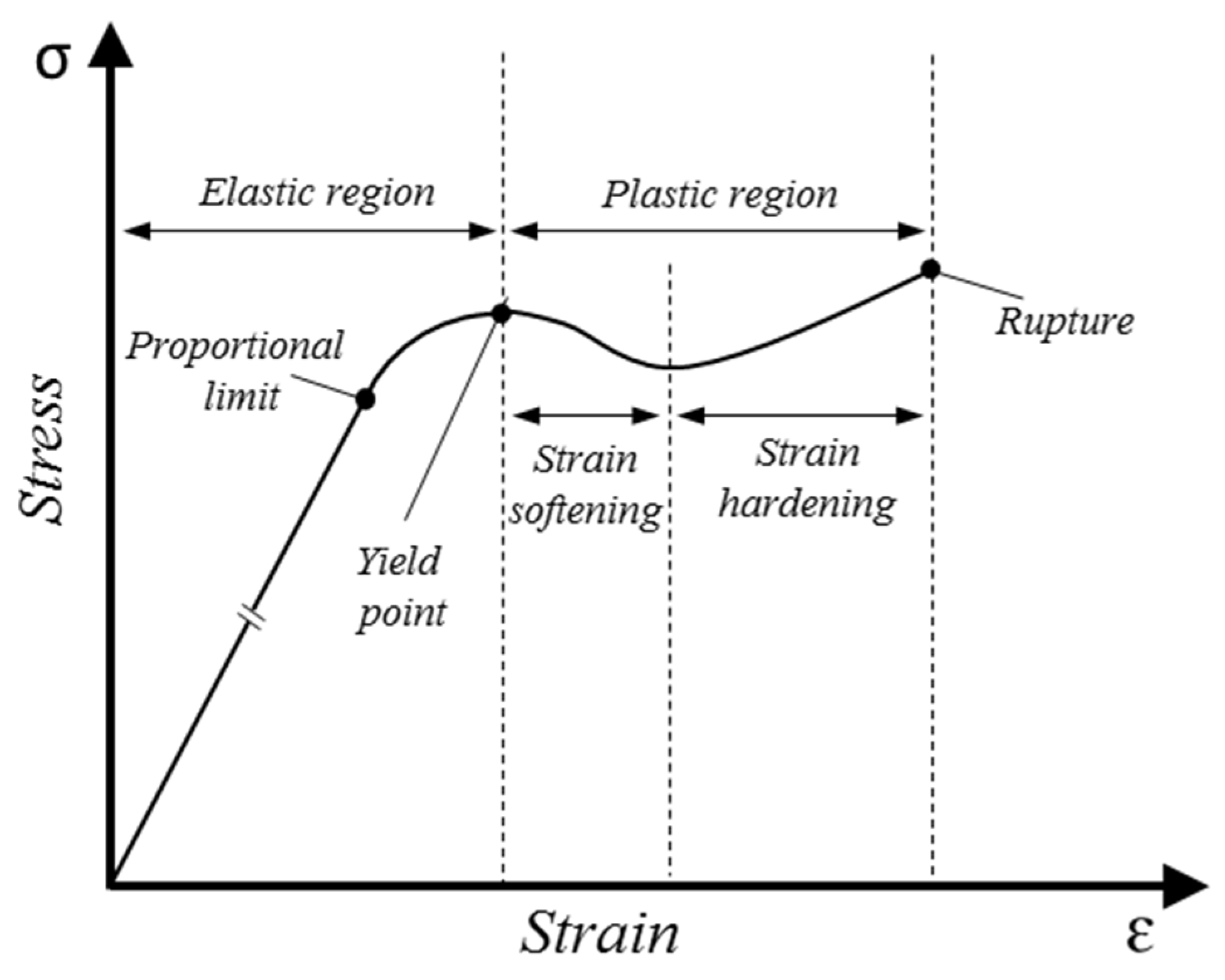
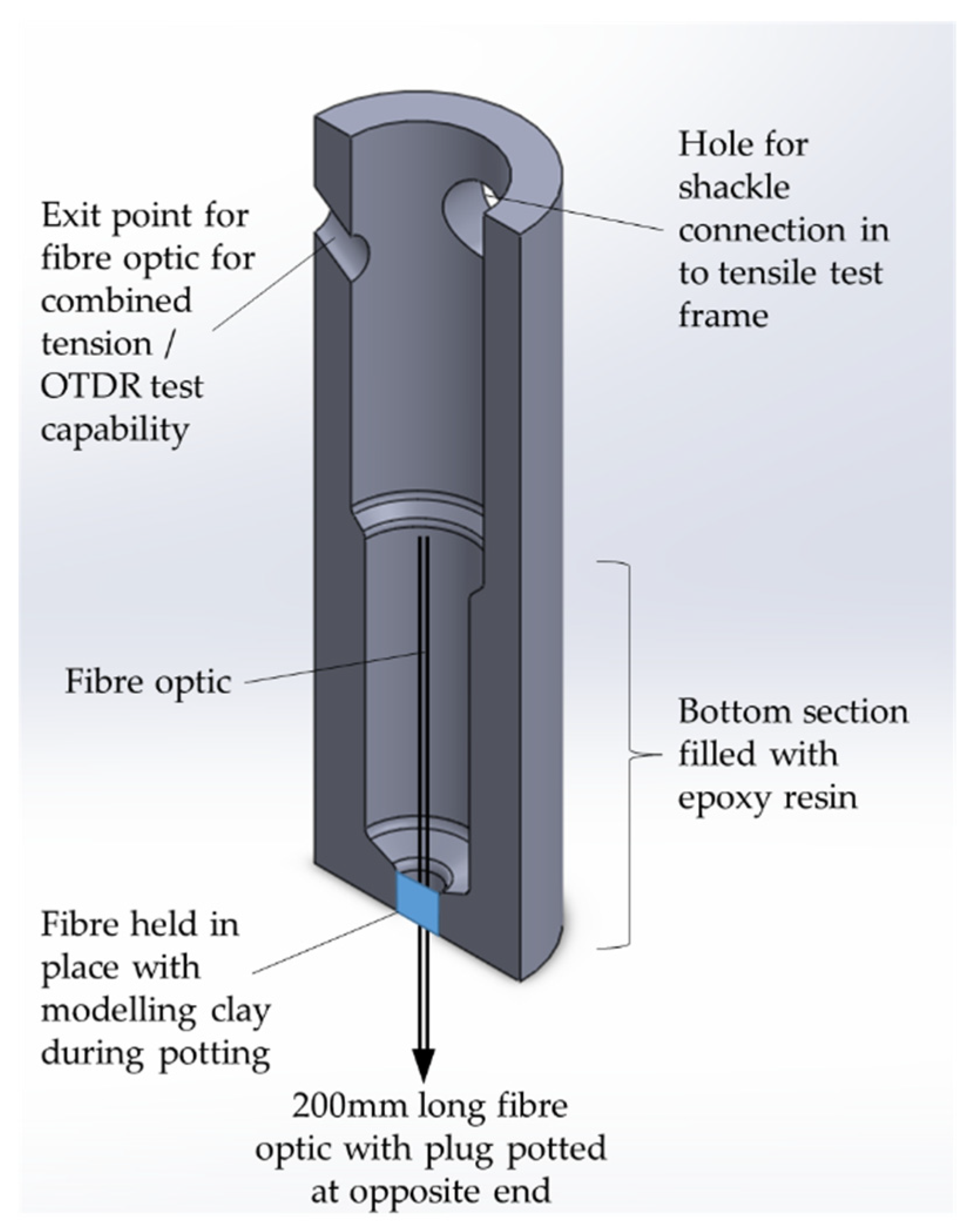

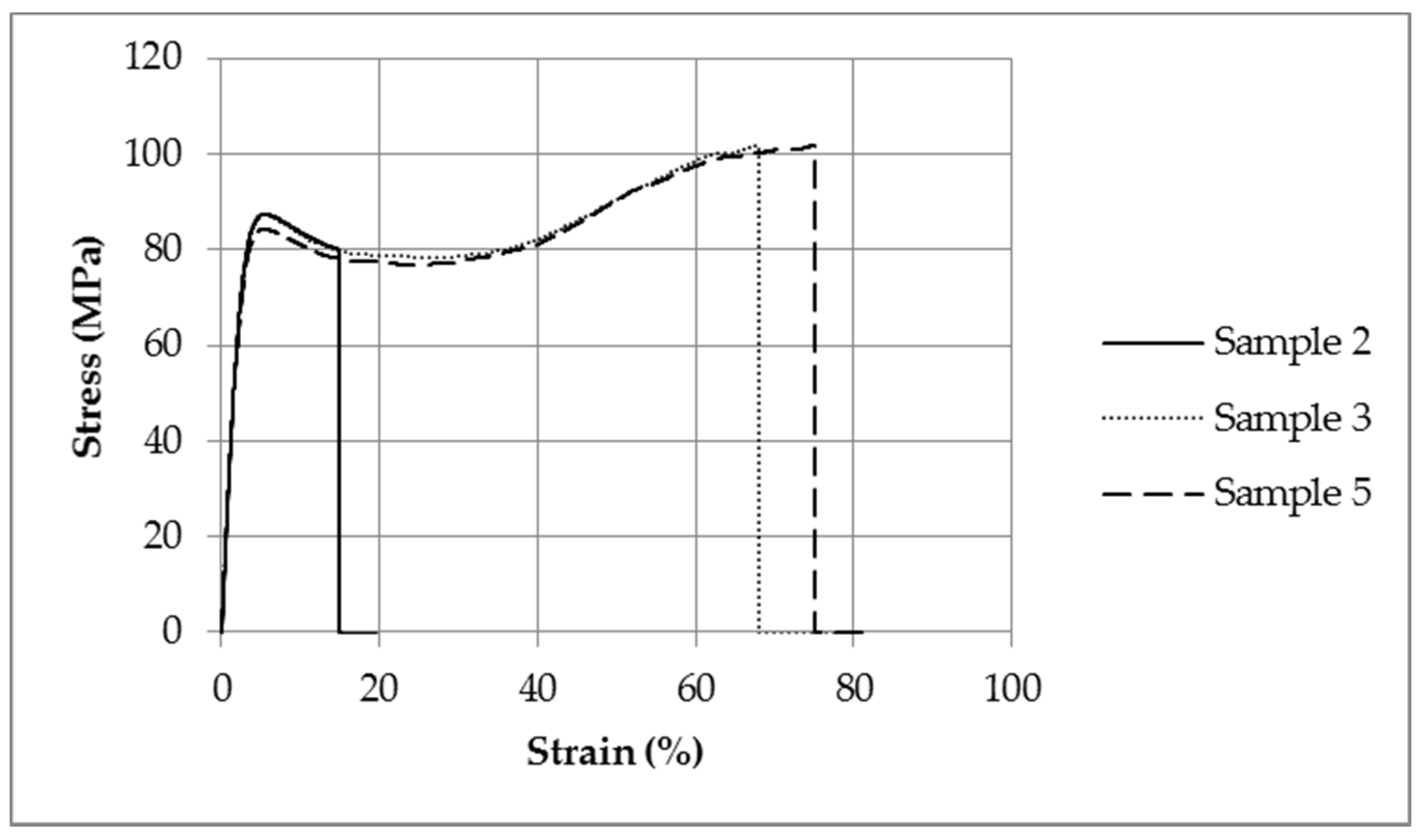
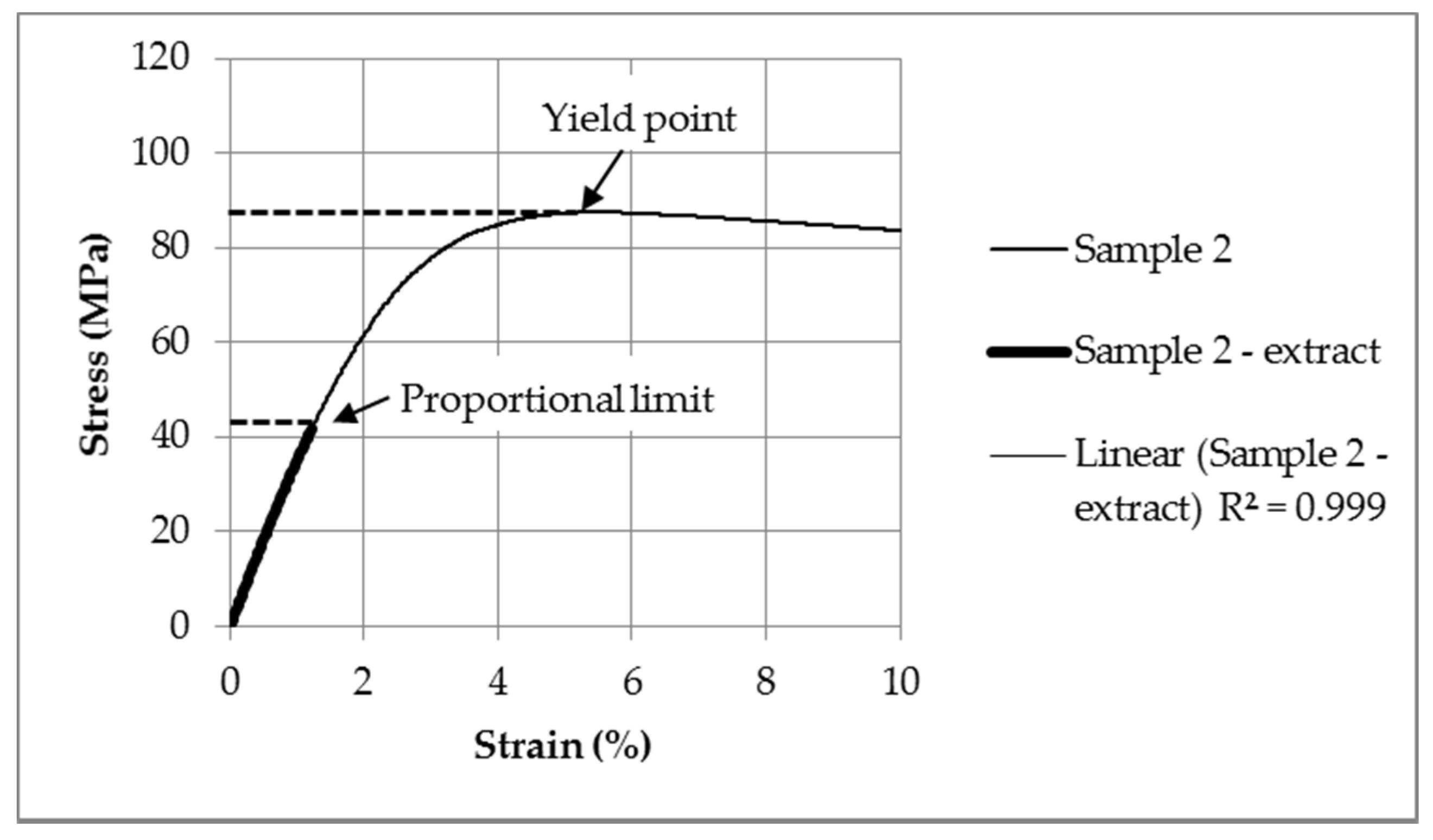
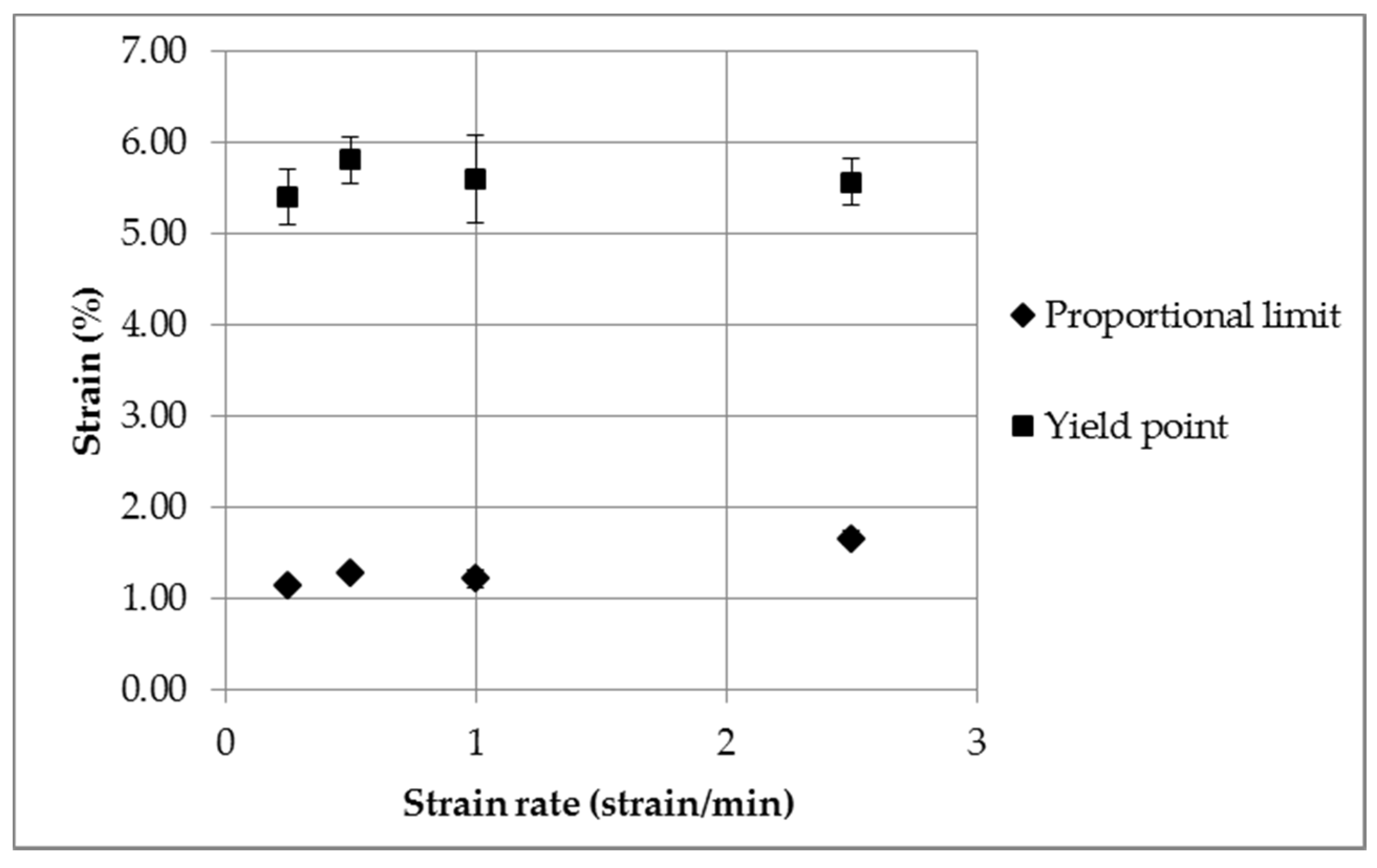
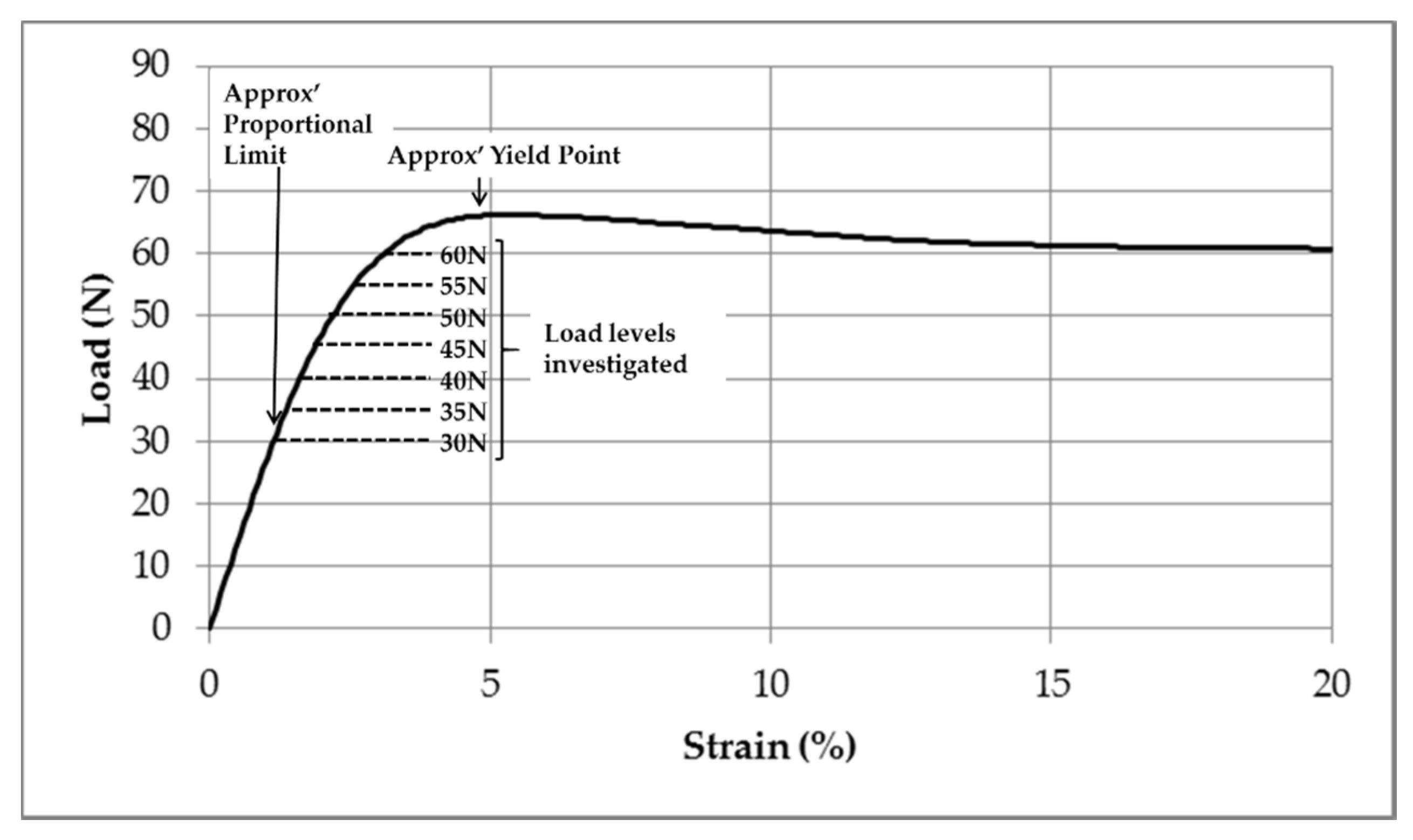
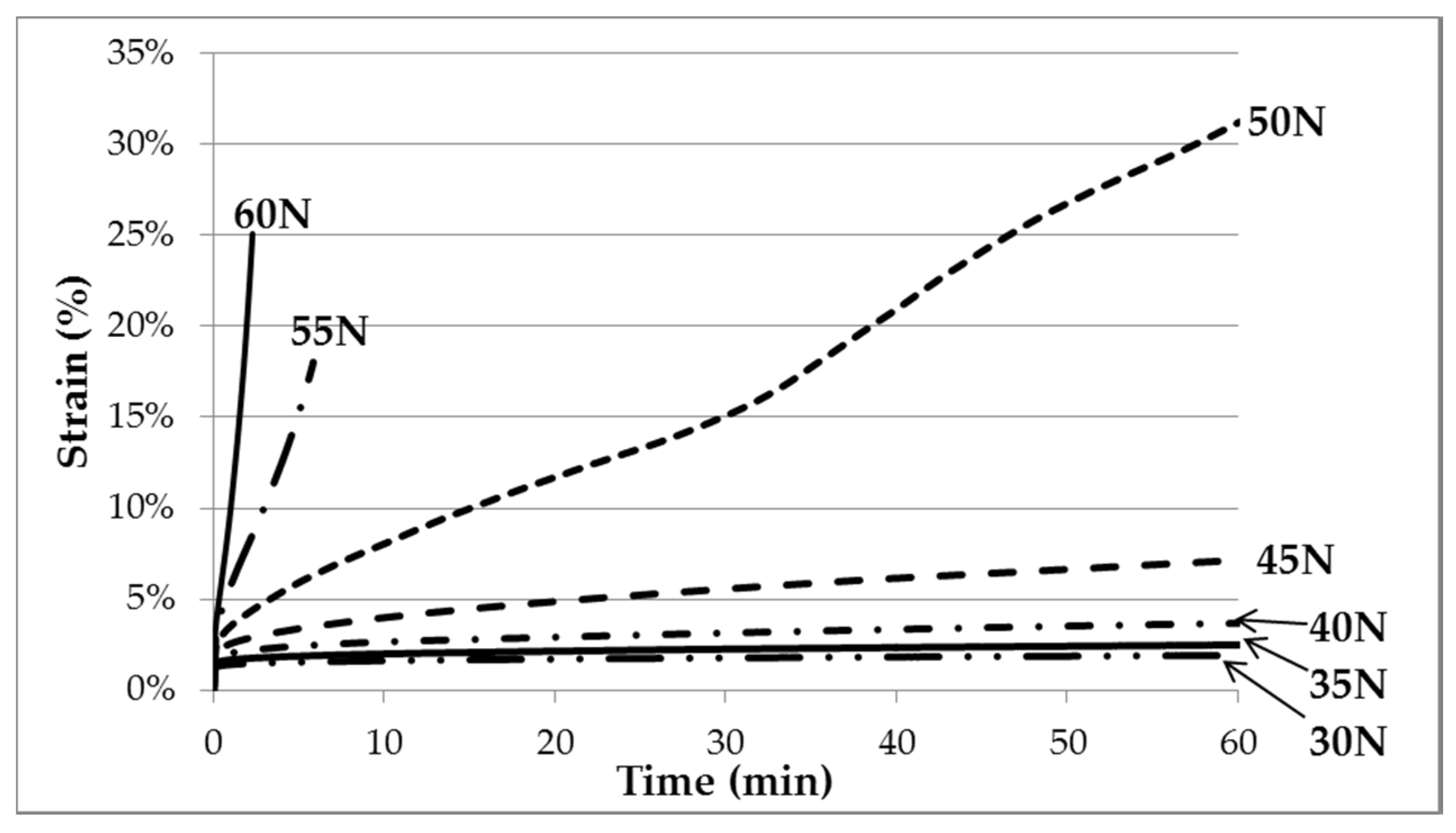
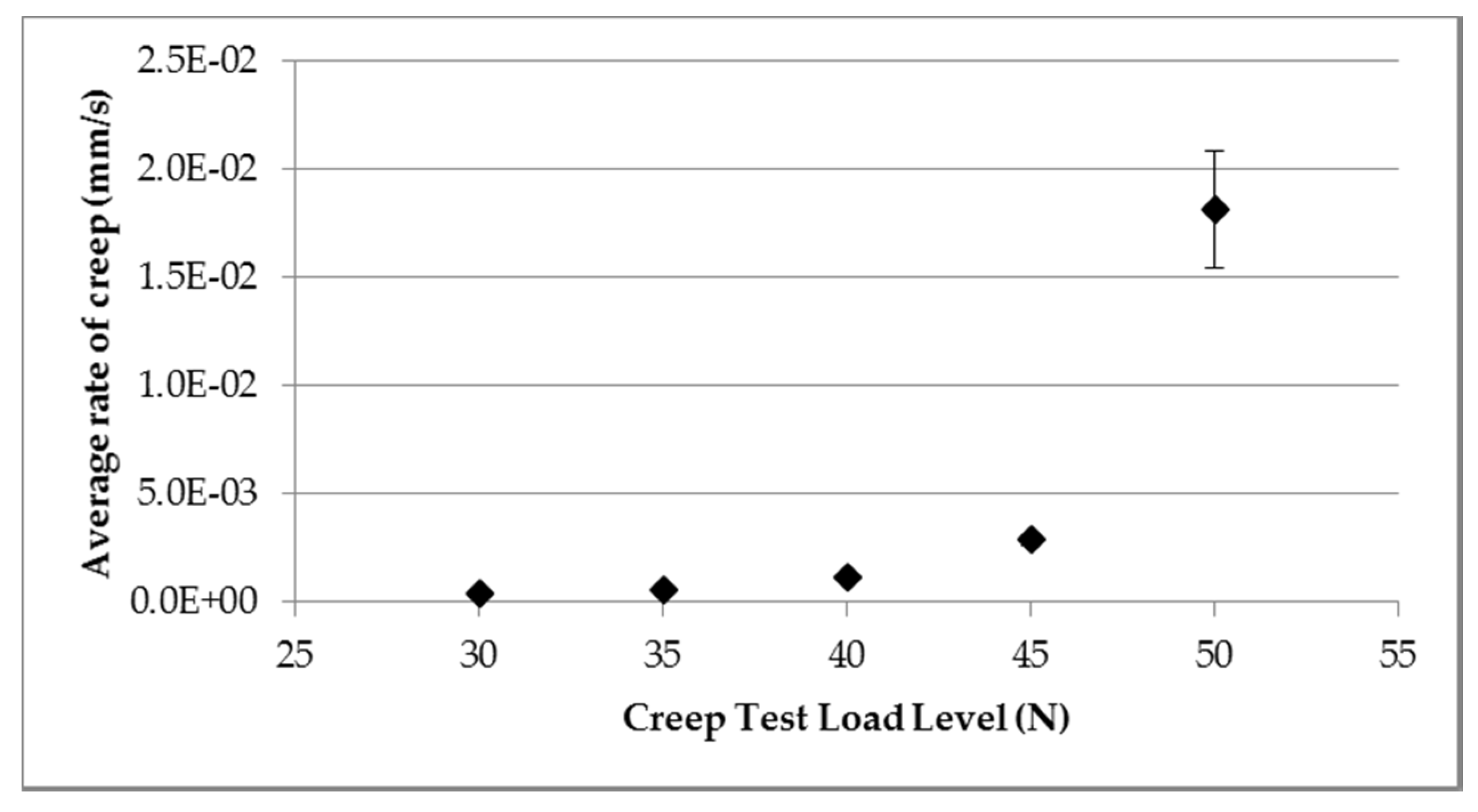
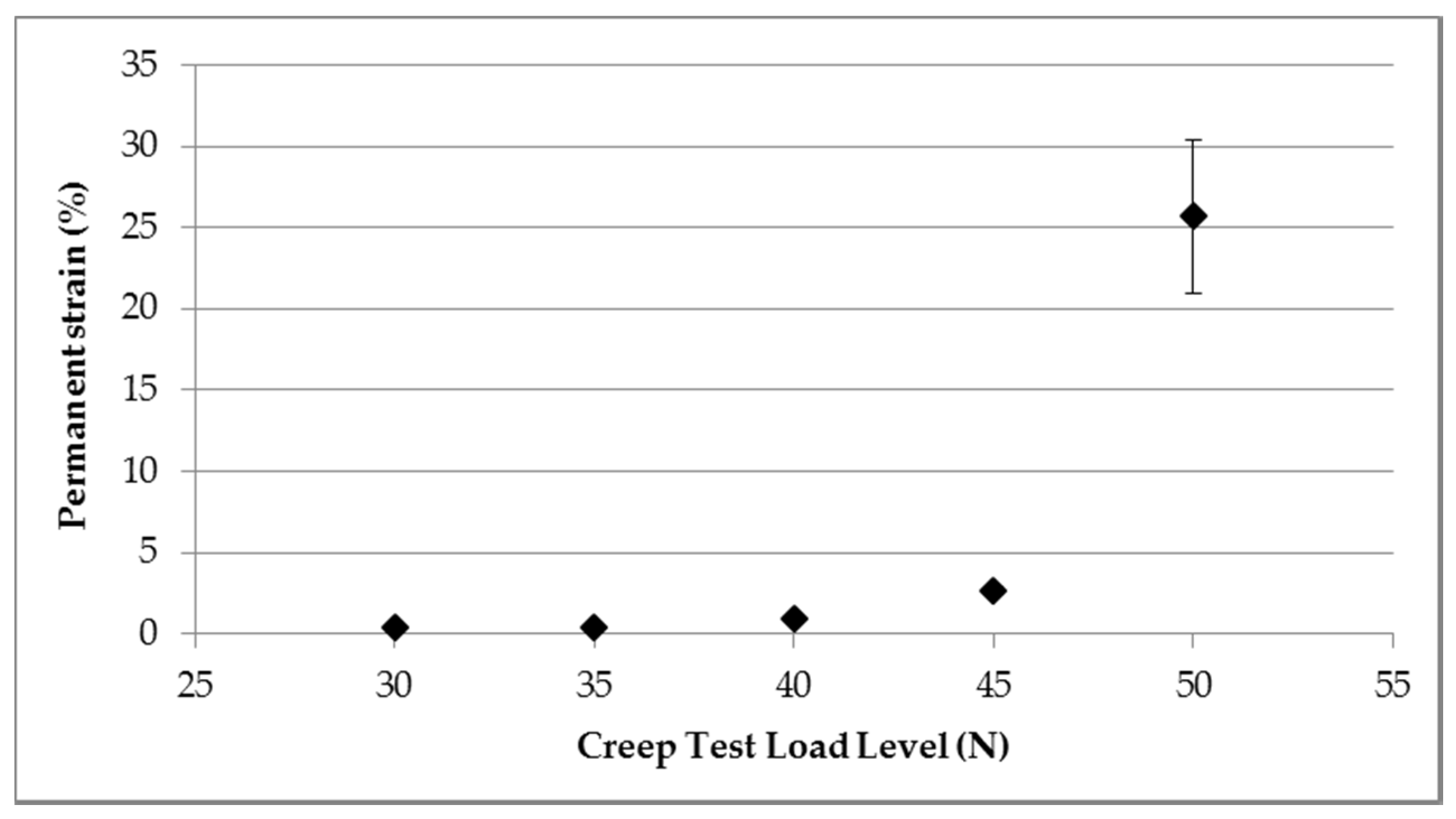
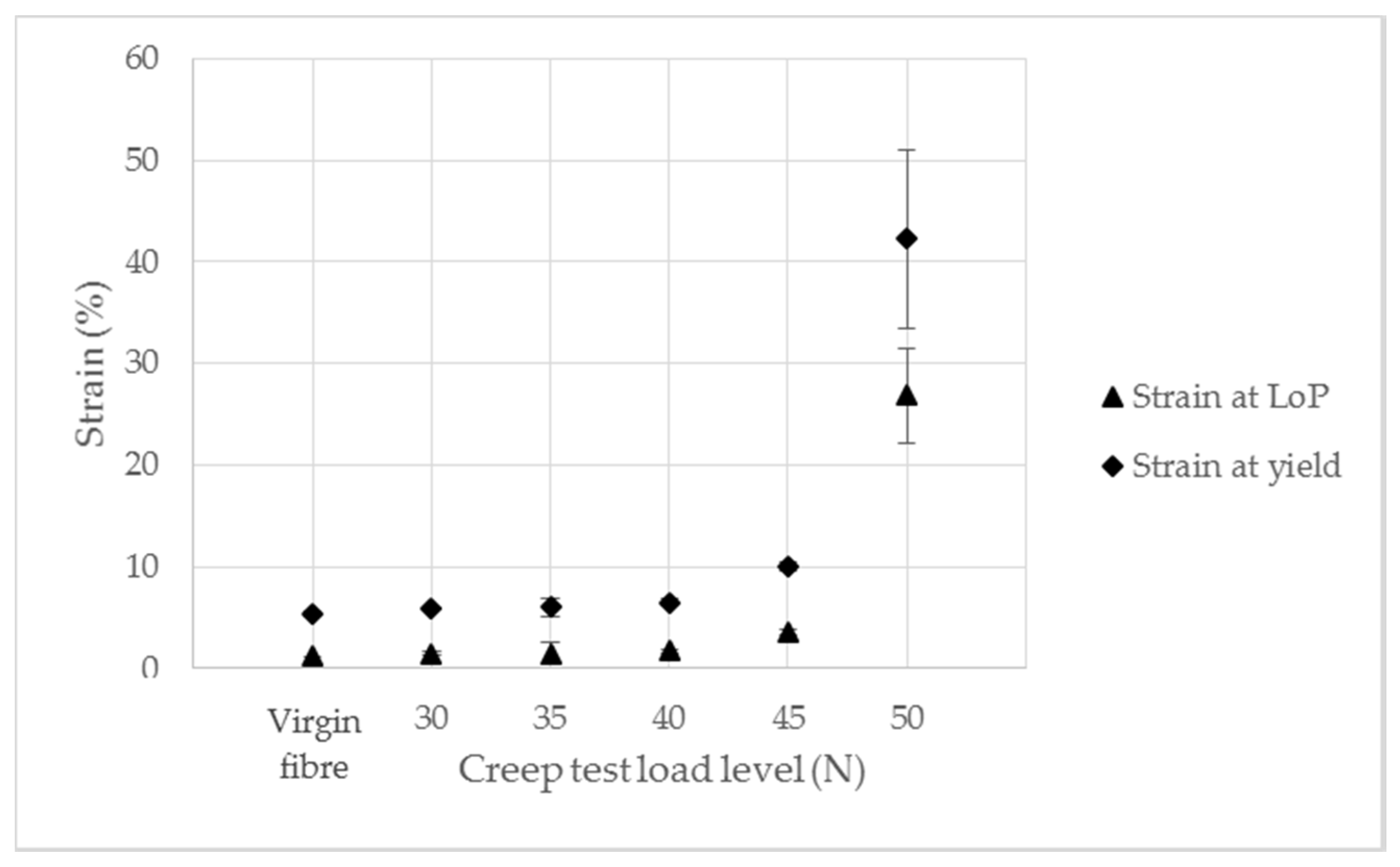
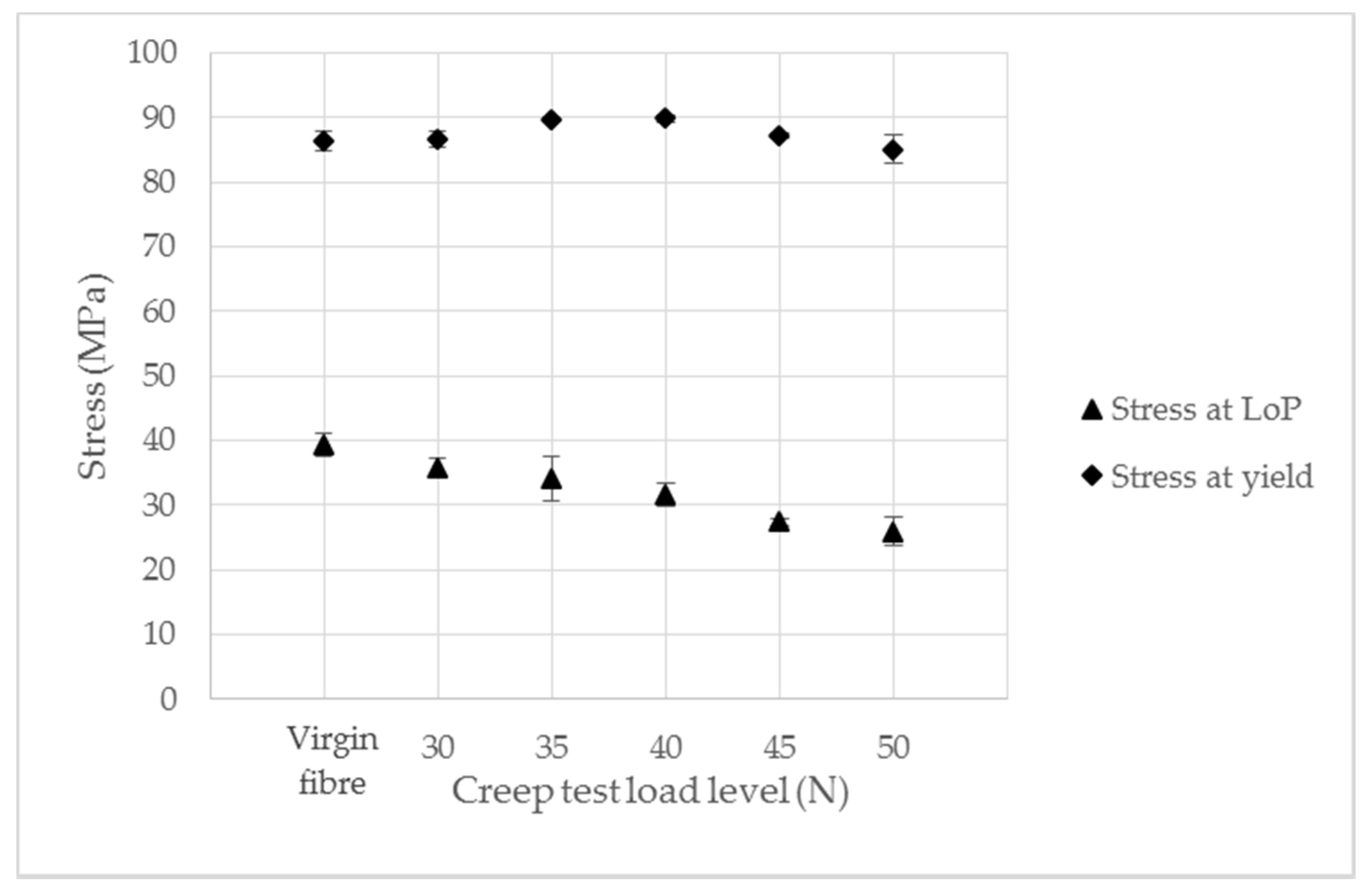
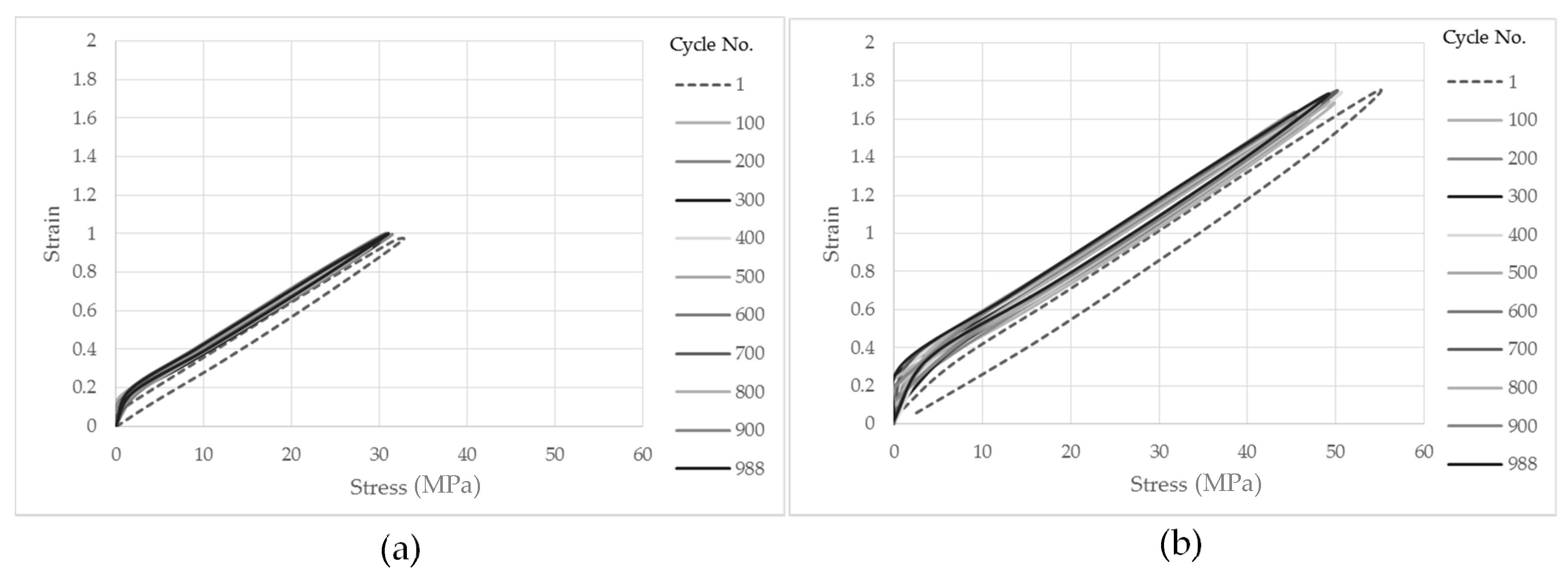
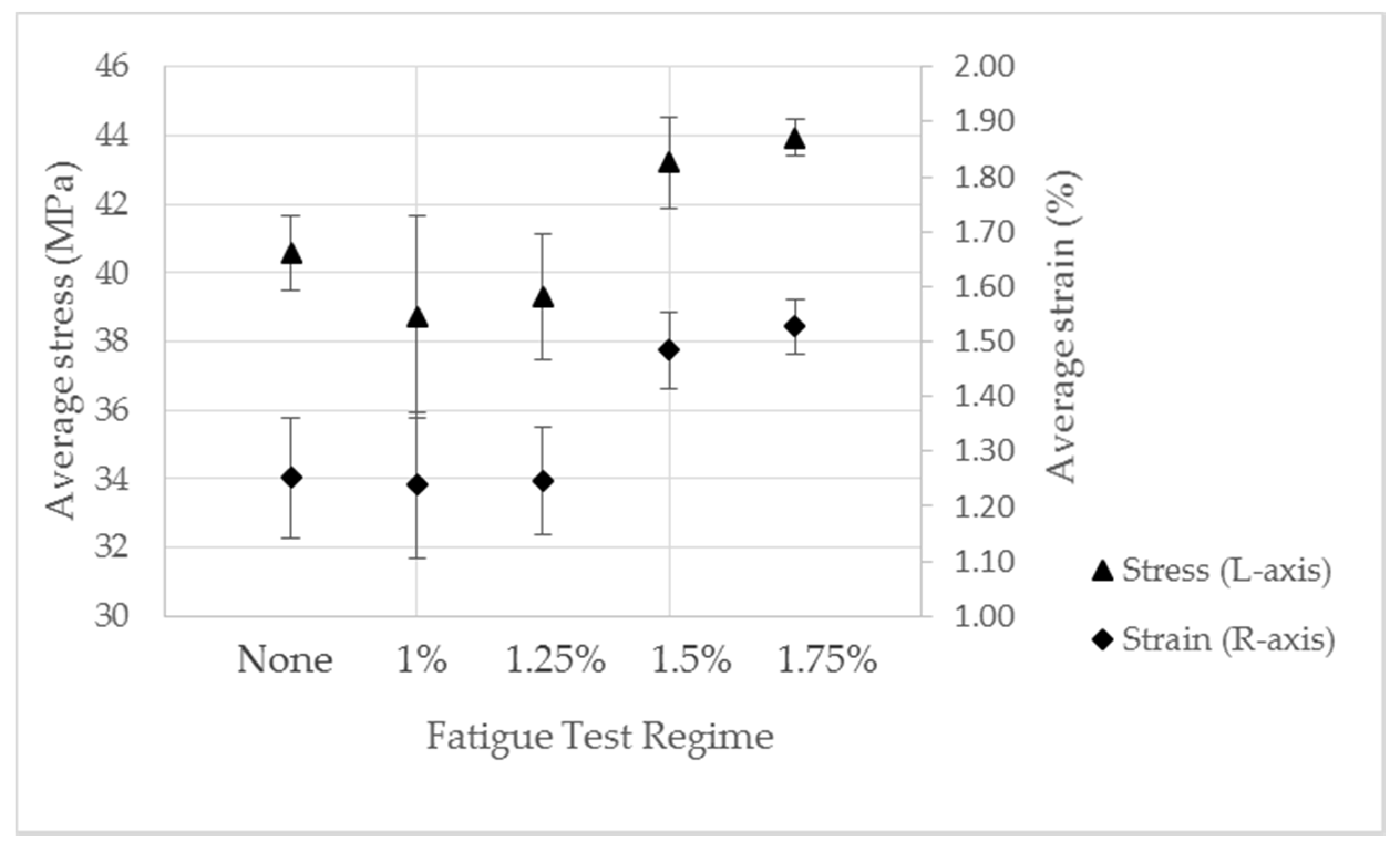
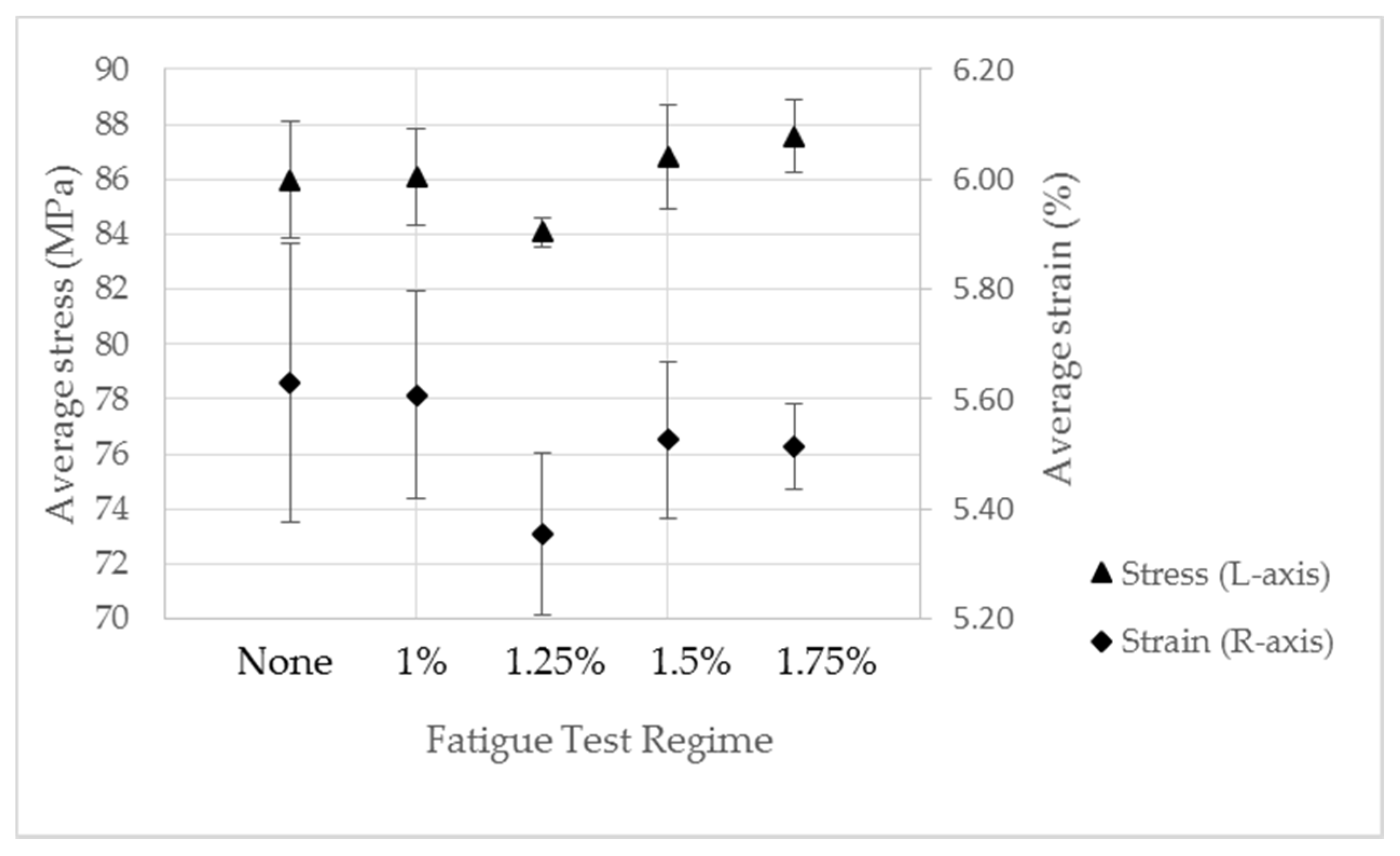
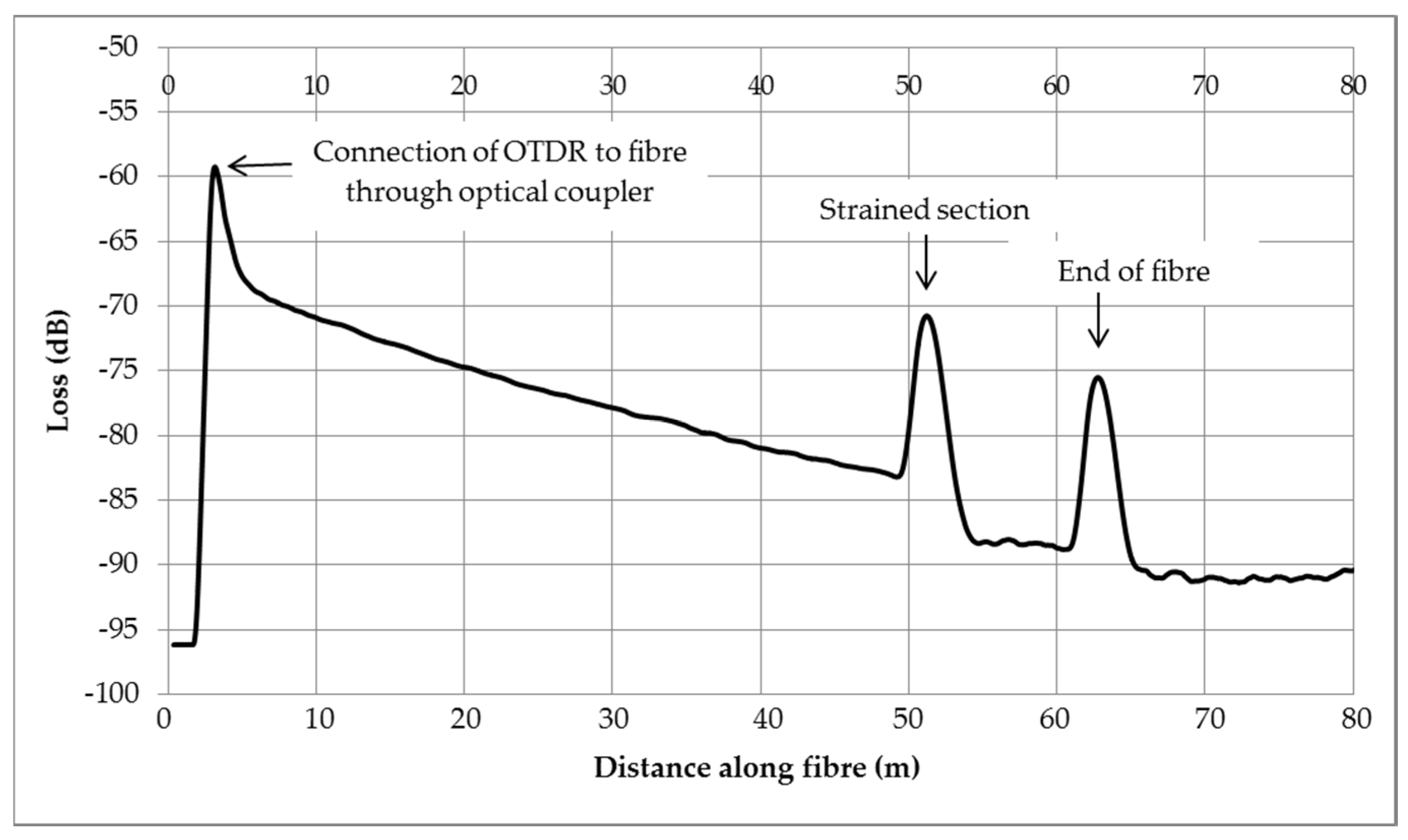
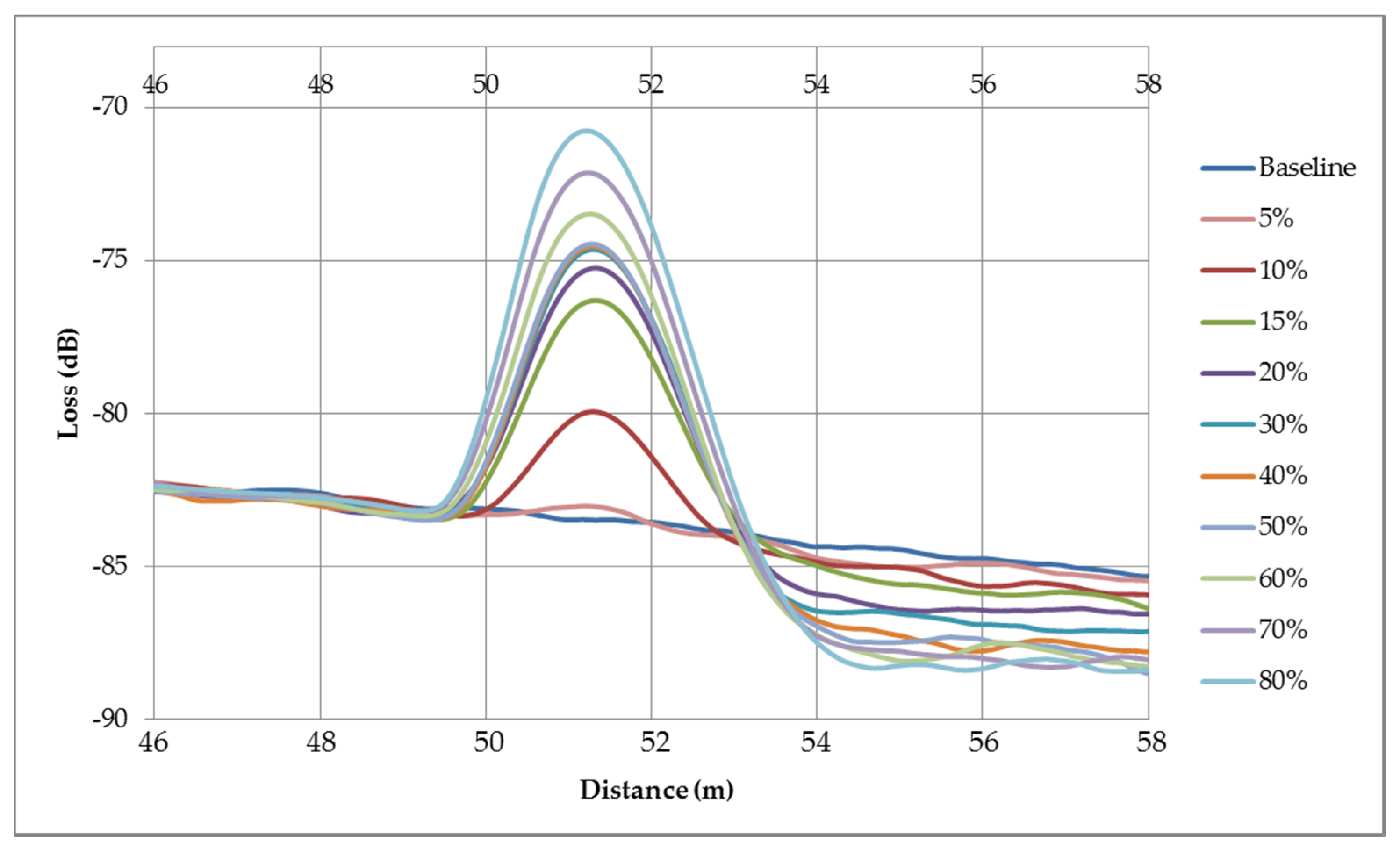
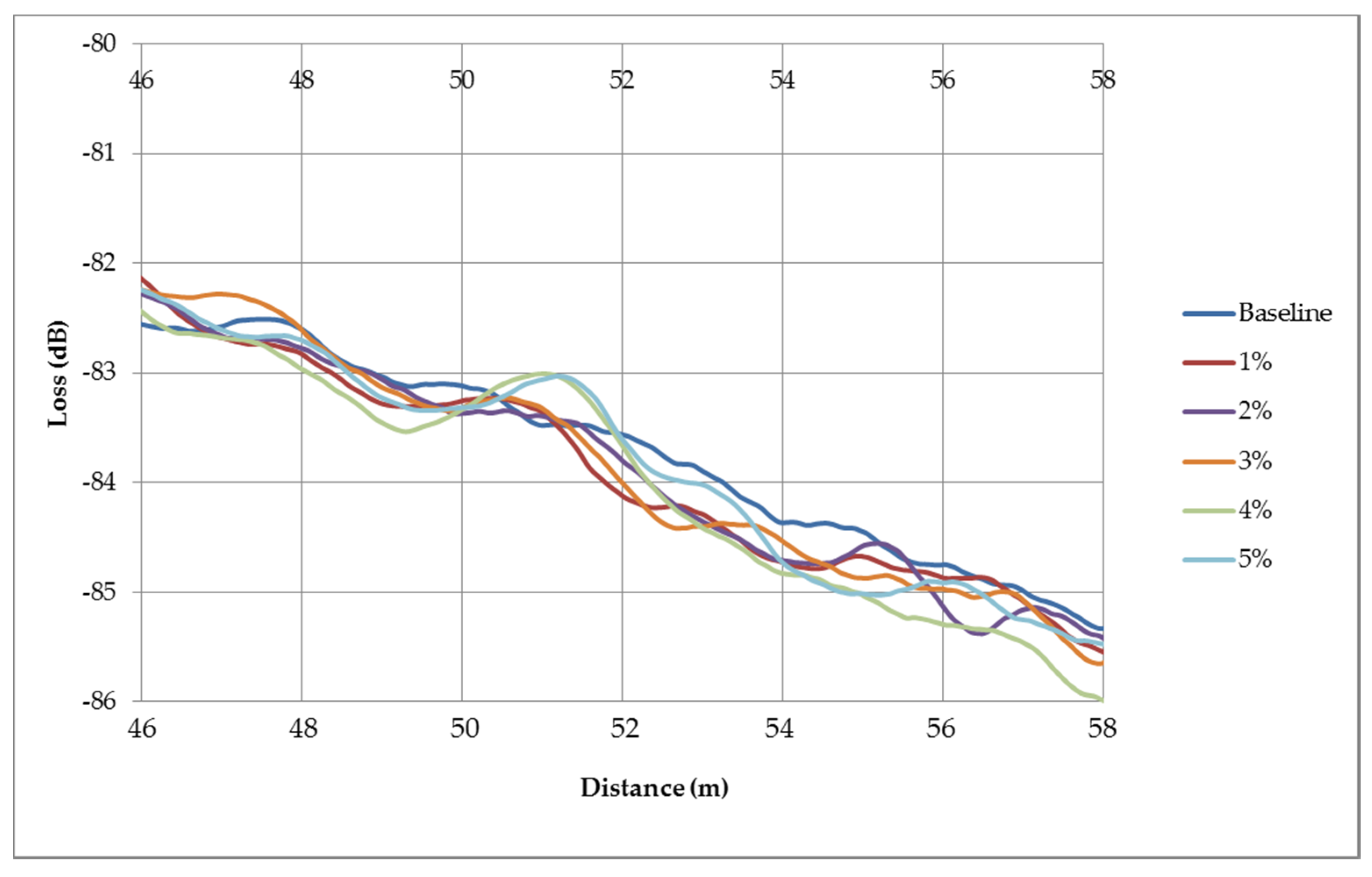

| Specification | PMMA Fibre |
|---|---|
| Core material | Poly methyl methacrylate |
| Cladding | Fluorinated polymer |
| Jacket | None |
| Min bend radius (loss increment < 0.5 dB at quarter bend) | 25 mm |
| Tensile strength (tensile force at 5% strain) | 65 N |
| Core diameter (min/typical/max) | 920/980/1040 µm |
| Cladding diameter (min/typical/max) | 940/1000/1060 µm |
| Displacement Range | Displacement Increment | Equivalent Strain Increment |
|---|---|---|
| 0–9 mm | 0.2 mm | 0.1% |
| 9–30 mm | 0.5 mm | 0.25% |
| 30–50 mm | 1 mm | 0.5% |
| 50–160 mm | 5 mm | 2.5% |
| Strain Rate | Proportional Limit | Yield Point | ||||
|---|---|---|---|---|---|---|
| Average Load (N) | Average Stress (MPa) | Average Strain (%) | Average Load (N) | Average Stress (MPa) | Average Strain (%) | |
| SR1: 0.25 /min (50 mm/min) | 30.93 | 39.38 | 1.16 | 67.88 | 86.43 | 5.41 |
| SR2: 0.5 /min (100 mm/min) | 34.44 | 43.85 | 1.29 | 71.92 | 91.57 | 5.81 |
| SR3: 1 /min (200 mm/min) | 32.74 | 41.69 | 1.22 | 74.13 | 94.38 | 5.61 |
| SR4: 2.5 /min (500 mm/min) | 44.31 | 56.42 | 1.66 | 80.78 | 102.86 | 5.57 |
© 2020 by the authors. Licensee MDPI, Basel, Switzerland. This article is an open access article distributed under the terms and conditions of the Creative Commons Attribution (CC BY) license (http://creativecommons.org/licenses/by/4.0/).
Share and Cite
Gordelier, T.; Thies, P.R.; Rinaldi, G.; Johanning, L. Investigating Polymer Fibre Optics for Condition Monitoring of Synthetic Mooring Lines. J. Mar. Sci. Eng. 2020, 8, 103. https://doi.org/10.3390/jmse8020103
Gordelier T, Thies PR, Rinaldi G, Johanning L. Investigating Polymer Fibre Optics for Condition Monitoring of Synthetic Mooring Lines. Journal of Marine Science and Engineering. 2020; 8(2):103. https://doi.org/10.3390/jmse8020103
Chicago/Turabian StyleGordelier, Tessa, Phillip Rudolph Thies, Giovanni Rinaldi, and Lars Johanning. 2020. "Investigating Polymer Fibre Optics for Condition Monitoring of Synthetic Mooring Lines" Journal of Marine Science and Engineering 8, no. 2: 103. https://doi.org/10.3390/jmse8020103
APA StyleGordelier, T., Thies, P. R., Rinaldi, G., & Johanning, L. (2020). Investigating Polymer Fibre Optics for Condition Monitoring of Synthetic Mooring Lines. Journal of Marine Science and Engineering, 8(2), 103. https://doi.org/10.3390/jmse8020103






